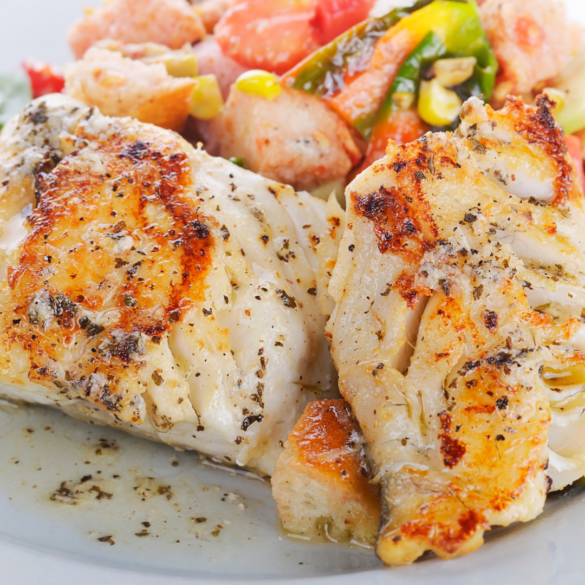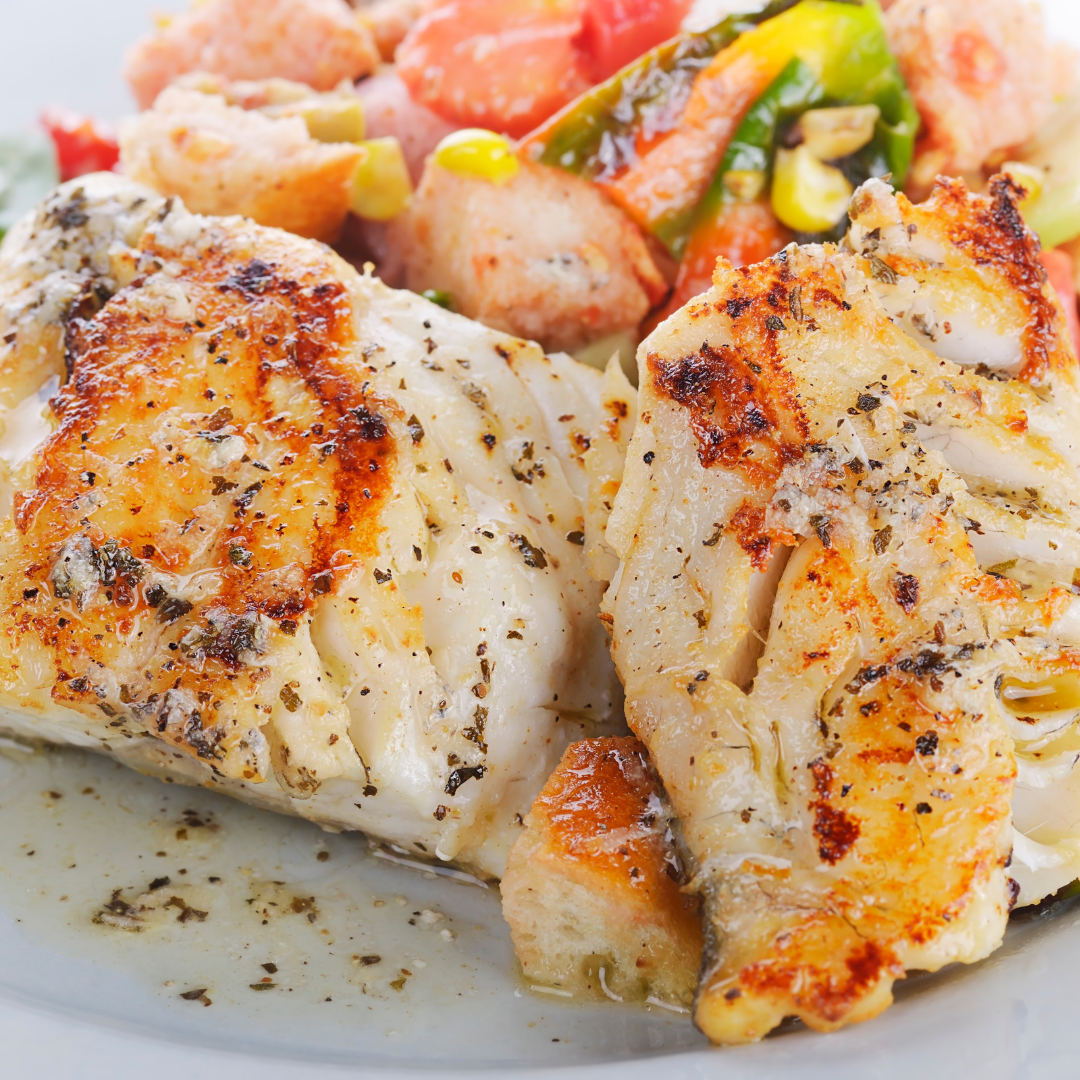Have you ever tasted the truly delightful and distinct flavors of Smoked Mahi Mahi? If not, prepare for a treat that’s going to transform your palate forever. Also known as dorado, this fish is loved by recreational anglers, sport fishers, and food connoisseurs alike due to its unique taste, vibrant color, and healthy attributes.
How to make Smoked Mahi Mahi
Smoked Mahi Mahi, also known as dolphinfish or dorado, is prepared using smoking techniques. Mahi Mahi is a popular saltwater fish known for its firm texture and mild, sweet flavor.
Ingredients
- 2 Mahi Mahi fillets (approximately 1 lb. each, skin on for retaining moisture and flavor)
- 2 tablespoons olive oil (extra virgin works best for added flavor)
- Salt (to taste, Himalayan pink salt or sea salt recommended)
- Freshly ground black pepper (to taste)
- 1 lemon (for zest and juice, adding a citrusy freshness)
- 1 tablespoon garlic powder (for that punch of flavor)
- 1 teaspoon smoked paprika (for a hint of smokiness and color)
- Optional: Fresh herbs (like dill, parsley, or cilantro for garnishing)
Equipment
- Smoker (Preferably one that allows you to control the temperature)
- Wood chips (Apple or cherry wood adds a subtle, sweet smokiness that complements the fish)
Instructions
- Preparing the Mahi Mahi: Begin by rinsing your Mahi Mahi fillets under cold water and patting them dry with paper towels. Coat each fillet lightly with olive oil. This not only adds flavor but also prevents the fish from sticking to the grill of the smoker.
- Seasoning: Generously season both sides of the fillets with salt, freshly ground black pepper, garlic powder, and smoked paprika. For an added zest, grate some lemon zest over the fillets and drizzle them with a bit of lemon juice.
- Preheating the Smoker: Preheat your smoker to a steady temperature of 225°F (107°C). This low and slow approach is perfect for fish, allowing the smoke to penetrate deeply while keeping the fillet moist and tender.
- Smoking the Mahi Mahi: Once your smoker reaches the desired temperature, place the Mahi Mahi fillets skin-side down on the grill. Close the lid and let the magic happen for about 1 to 1.5 hours. The exact time might vary depending on the thickness of the fillets and the type of smoker, so it’s good to check at the 1-hour mark.
- Wood Chips: Add the wood chips to your smoker according to the manufacturer’s instructions. The key is to keep a consistent smoke without overpowering the fish.
- Checking for Doneness: The Mahi Mahi is done when it reaches an internal temperature of 137°F (58°C) and flakes easily with a fork but is still moist inside.
Tips for the Perfect Smoked Mahi Mahi
- Don’t Overcook: Keep a close eye on the temperature. Overcooking can dry out the fish and return it to the ocean in spirit.
- Resting: Let the fish rest for a few minutes after taking it out of the smoker. This helps redistribute the juices throughout the fillet.
- Serving: Serve on a plate with a side of your choice, garnish with fresh herbs, and perhaps a squeeze more of lemon juice for that extra zing.
- Pairing: Enjoy your smoked Mahi Mahi with a light, crisp salad, some roasted vegetables, or even a tropical fruit salsa to enhance the flavors.
What to serve with
The beautiful smoked Mahi Mahi, with its rich, smoky, and slightly sweet flavor, is undoubtedly the star of the show. However, like every great performer, it needs an able supporting cast to shine truly. Here are some delightful side dish ideas that you can pair with this delectable main course to create a well-rounded culinary experience.
1. Tropical Mango Salsa
The delicate, smoky taste of mahi mahi pairs wonderfully with the bright, refreshing notes of a tropical fruit salsa. Combining chunks of ripe mango with diced avocado, finely chopped red onion, cilantro, and a squeeze of fresh lime juice creates a vibrant and tangy salsa that contrasts beautifully with the smoked fish.
2. Citrus Infused Quinoa Salad
You already have a touch of citrus in the mahi mahi recipe through the lemon zest. Pair this smoked fish with a light, airy quinoa salad featuring a splash of citrus. Mix cooked quinoa with a variety of colorful vegetables, like cherry tomatoes, cucumbers, and bell peppers. Finish the salad with a citrusy vinaigrette made with freshly squeezed lime or orange juice, olive oil, honey, and a hint of garlic.
3. Grilled Seasonal Vegetables
Vegetables grilled alongside your mahi mahi not only simplify your meal preparation but also offer a beautiful smoky side that naturally complements the fish. Choose seasonal vegetables for the freshest flavors. Some favorites include zucchini, bell peppers, asparagus, and cherry tomatoes; simply toss in olive oil, season with salt and pepper, and grill until tender, retaining a bit of crunch.
4. Lemon and Herb Couscous
This light, fluffy side dish with a hint of lemon and fresh herbs enhances the smoky flavor of the fish without overpowering it. Cook the couscous in chicken or vegetable broth, add a touch of lemon zest and juice, and stir in your favorite chopped fresh herbs such as parsley, dill, or mint before serving.
5. Creamy Coleslaw
Crunchy, creamy coleslaw adds a refreshing contrast to the smoky, slightly sweet taste of the mahi mahi. Shred a mix of green and red cabbage, and finely slice some carrots. Toss these in a light dressing made of mayonnaise, vinegar, a bit of sugar, and some Dijon mustard to get that tanginess.
Ingredients substitutes
When making Smoked Mahi Mahi, not everyone might have access to all the specific ingredients recommended, or perhaps dietary restrictions or preferences necessitate substitutions. Here’s a detailed guide on how to adapt and substitute key ingredients without compromising the delightful essence of the dish.
Mahi Mahi Substitutes
- Salmon: Similar in texture, and when smoked, salmon offers a rich, oily flavor that absorbs the smoky essence beautifully. It’s a great substitute that’s widely available.
- Halibut: For those preferring a leaner option, halibut stands up well to smoking with its firm, meaty texture, making it a decent alternative.
- Tuna Steaks: Thick tuna steaks can also be a good substitute for Mahi Mahi. Keep in mind; tuna is best smoked to medium-rare or medium to retain moisture.
Olive Oil Substitutes
- Avocado Oil: With its neutral flavor and high smoke point, avocado oil is an excellent alternative for brushing on the fish before smoking.
- Coconut Oil (Melted): Coconut oil brings a slightly sweet note, which can complement the inherent sweetness of the Mahi Mahi. It’s excellent for those who enjoy a tropical hint in their dishes.
Seasoning Substitutes
- Lemon Zest & Juice: If lemon is not available, lime can offer a similar citrus zing that cuts through the smokiness, enhancing the fish’s flavor. Orange zest and juice can also be used for a sweeter citrus note.
- Garlic Powder: Fresh minced garlic or shallots can be used in place of garlic powder. They must be finely minced to ensure they coat the fish evenly.
- Smoked Paprika: For those who might not have smoked paprika at hand or prefer a different taste profile, a combination of regular paprika with a pinch of cumin can mimic that smoky, earthy flavor. Alternatively, a little chipotle powder can add both smokiness and a touch of heat.
Wood Chips Options
- Apple Wood Chips: If you’re unable to find apple wood, cherry wood offers a similarly mild, slightly sweet smoke that doesn’t overpower the delicate flavor of Mahi Mahi.
- Hickory or Mesquite: For a stronger smoke flavor, hickory or mesquite can be used, but in smaller quantities to avoid overwhelming the fish. These woods pair better with more robust flavors like salmon if you’re substituting the Mahi Mahi.
Garnishing & Serving Options
- Fresh Herbs: If specific herbs are recommended as garnish and are not available, most fresh herbs can serve as substitutes based on personal preference. Parsley, cilantro, or even basil can provide a fresh finishing touch.
- Sides: The sides mentioned (like tropical salsa or grilled vegetables) can be tailored to what’s seasonally available or to dietary needs. Feel free to experiment with starches (like sweet potato instead of quinoa) or different vegetables based on preference and availability.
Final Thoughts
The joy of creating Smoked Mahi Mahi isn’t limited to the moment of serving or savoring it. It’s about the journey. From selecting fresh fillets, seasoning them with care, patiently tending to their smoking process, to finally seeing them transform into a thing of beauty—it’s the culmination of several small steps, each beaming with love, passion, and care.
More Seafood Recipes:
- Red Lobster Stuffed Mushrooms Recipe
- Shrimp Portofino
- Outback Steakhouse Coconut Shrimp
- Easy Seafood Bread


Ingredients
- 2 Mahi Mahi fillets (approximately 1 lb. each, skin on for retaining moisture and flavor)
- 2 tablespoons olive oil (extra virgin works best for added flavor)
- Salt (to taste, Himalayan pink salt or sea salt recommended)
- Freshly ground black pepper (to taste)
- 1 lemon (for zest and juice, adding a citrusy freshness)
- 1 tablespoon garlic powder (for that punch of flavor)
- 1 teaspoon smoked paprika (for a hint of smokiness and color)
- Optional: Fresh herbs (like dill, parsley, or cilantro for garnishing)
Instructions
- Preparing the Mahi Mahi: Begin by rinsing your Mahi Mahi fillets under cold water and patting them dry with paper towels. Coat each fillet lightly with olive oil. This not only adds flavor but also prevents the fish from sticking to the grill of the smoker.
- Seasoning: Generously season both sides of the fillets with salt, freshly ground black pepper, garlic powder, and smoked paprika. For an added zest, grate some lemon zest over the fillets and drizzle them with a bit of lemon juice.
- Preheating the Smoker: Preheat your smoker to a steady temperature of 225°F (107°C). This low and slow approach is perfect for fish, allowing the smoke to penetrate deeply while keeping the fillet moist and tender.
- Smoking the Mahi Mahi: Once your smoker reaches the desired temperature, place the Mahi Mahi fillets skin-side down on the grill. Close the lid and let the magic happen for about 1 to 1.5 hours. The exact time might vary depending on the thickness of the fillets and the type of smoker, so it's good to check at the 1-hour mark.
- Wood Chips: Add the wood chips to your smoker according to the manufacturer's instructions. The key is to keep a consistent smoke without overpowering the fish.
- Checking for Doneness: The Mahi Mahi is done when it reaches an internal temperature of 137°F (58°C) and flakes easily with a fork but is still moist inside.

